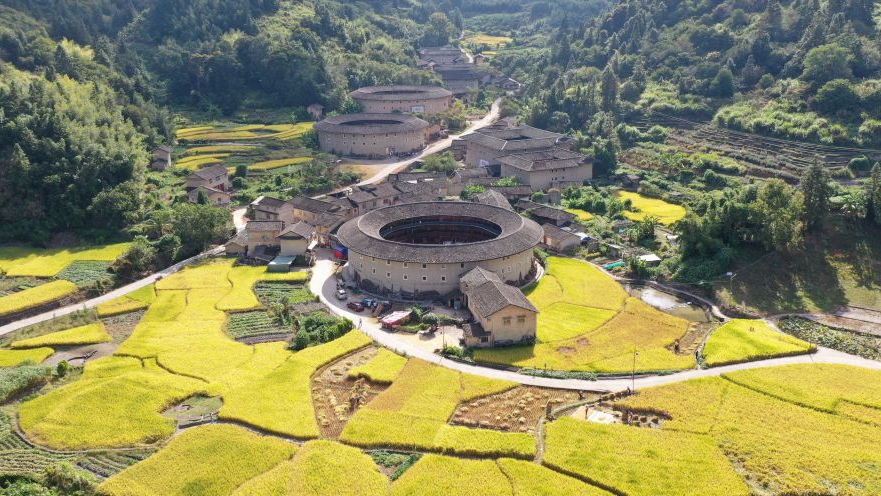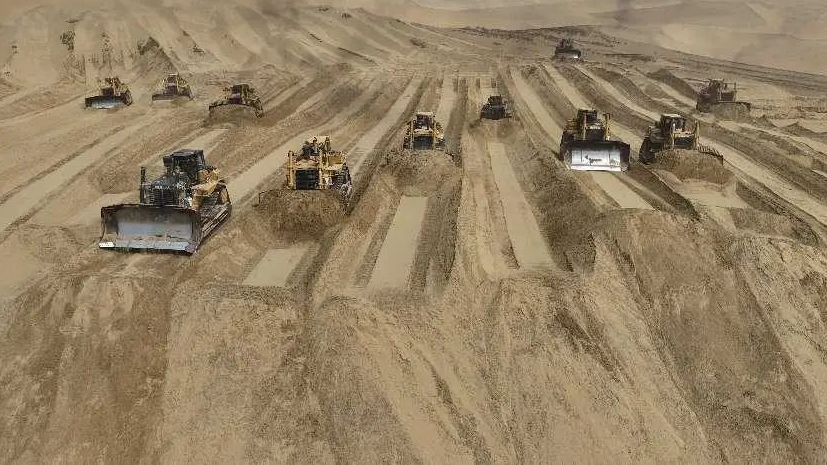China's modernization drive and its global inspiration
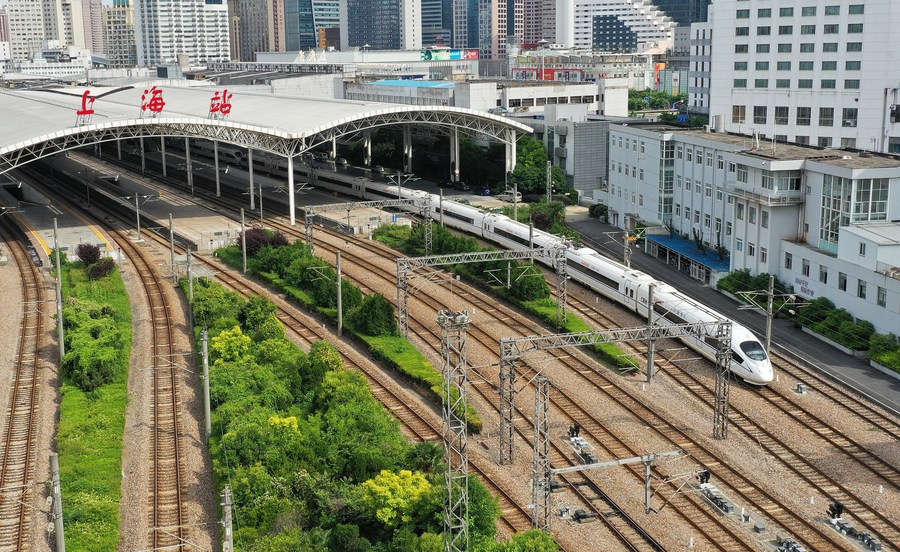
Aerial photo taken on May 18, 2022 shows a high-speed train pulling out of the Shanghai Railway Station in east China's Shanghai. (Xinhua/Li He)
The success of the CPC "comes from a constant adaptation of the party to the needs of the people and to the reality of the world at large," said Jean Christophe Iseux von Pfetten, president of the Institute for East-West Strategic Studies in Britain.
BEIJING, Oct. 15 (Xinhua) -- In its unprecedented stride toward modernization, China has worked the twin miracles of rapid economic development and long-term social stability.
While these achievements have amazed the global community, they have also made real differences to a world battling against headwinds from an unprecedented pandemic, flare-ups of regional conflicts and global economic stagnation. Observers worldwide believe that the Chinese path to modernization, especially its guiding philosophies, is inspiring other nations to seek their own development paths and the world to pursue a shared brighter future.
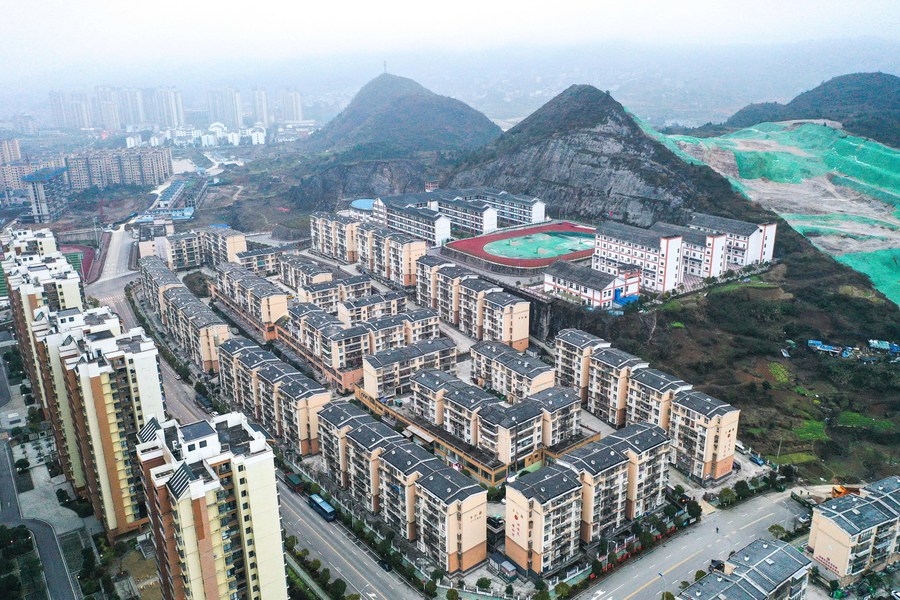
Aerial photo taken on Jan. 30, 2022 shows a relocation site for poverty alleviation in Kaili, southwest China's Guizhou Province. (Xinhua/Yang Wenbin)
PUTTING PEOPLE FIRST
Modernizing a country home to 1.4 billion people is a profound event in human history. Global observers have attributed China's success to the people-centered philosophy of the Communist Party of China (CPC). This is well illustrated by China's massive poverty alleviation campaign.
China announced in 2021 that the country had lifted the final 98.99 million impoverished rural residents living under the current poverty line out of poverty, and removed all 832 impoverished counties and 128,000 villages from the poverty list.
UN Secretary-General Antonio Guterres once commented that China's great achievements in poverty reduction constitute "the biggest contribution for dramatical reduction of poverty."
"China has a good experience in dealing with poverty," said Collen Vixen Kelapile, president of the United Nations Economic and Social Council.
"It's something that we need to congratulate the (Chinese) leadership for delivering for the Chinese people and hope that all of us can learn from that achievement," he said.
And over the past four decades, people's lives in China have been dramatically improved. A primarily agricultural country about 70 years ago, China now boasts the world's most extensive social welfare system, the largest high-speed railway network and cutting-edge technologies in many sectors.
The success of the CPC "comes from a constant adaptation of the party to the needs of the people and to the reality of the world at large," said Jean Christophe Iseux von Pfetten, president of the Institute for East-West Strategic Studies in Britain.
The CPC is "a party of people," Pfetten said. "And the party evolves and moves with the evolution of the people."

A worker welds solar power components at a workshop of the Jinko Solar (Yiwu) Co., Ltd. in Yiwu City, east China's Zhejiang Province, Jan. 15, 2021. (Xinhua/Huang Zongzhi)
A COMPREHENSIVE MODERNIZATION
China has been pursuing modernization in a comprehensive way. It has coordinated material and cultural-ethical progress, promoted economic, political, cultural, social and ecological development, and adhered to a new development philosophy that highlights innovation, coordination, greenness, openness and sharing.
When illustrating the features of China's modernization, Chinese President Xi Jinping noted that the country's modernization benefits a large population. It features common prosperity, coordinated material and cultural-ethical progress, harmony between humanity and nature, and peaceful development.
China's modernization pursues prosperity for all. In this aspect, east China's Zhejiang Province has become an exemplar as the region is building a demonstration zone for common prosperity by launching pairing-up arrangement between the developed coastal areas and the underdeveloped mountainous areas so as to bridge the gap between rural and urban regions.
"Lucid waters and lush mountains are invaluable assets." China's modernization drive also places high emphasis on seeking harmonious coexistence between humanity and nature. The country has cut its carbon emission intensity by 34.4 percent over the past 10 years, and pledged to have CO2 emissions peak before 2030 and achieve carbon neutrality before 2060.
Noting "environmental protection has been integrated into all of the country's socio-economic development plans," Neak Chandarith, director of the Cambodia 21st Century Maritime Silk Road Research Center, said, "with strong economic strength, advanced technological capability and high responsibility, China has played a leading role in combating global climate change."
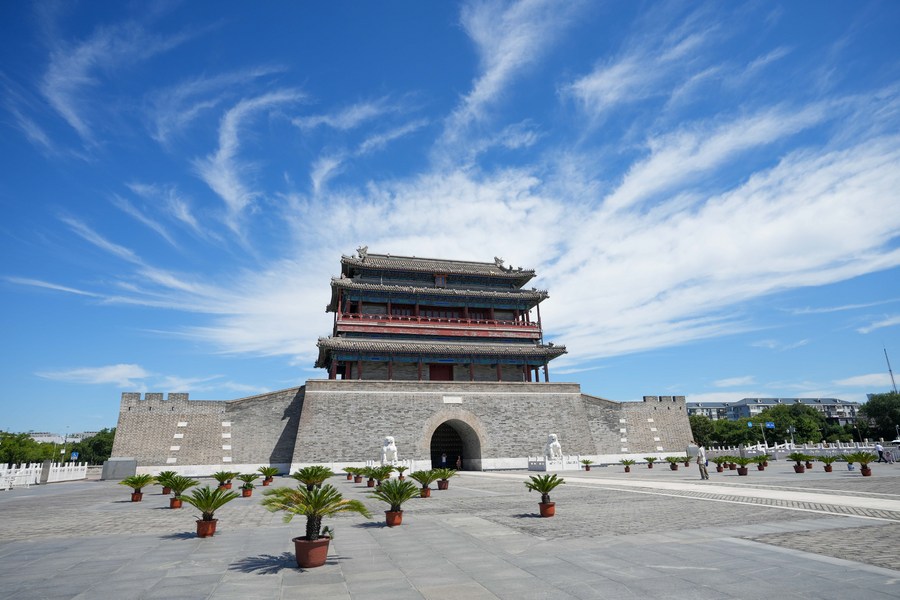
Photo taken on Aug. 16, 2022 shows the scene of Yongdingmen (Gate of Perpetual Peace) in Beijing, capital of China. (Xinhua/Ju Huanzong)
PEACEFUL DEVELOPMENT
Peaceful development has also distinguished China's modernization from that of the West. In contrast with Western colonialists who resorted to wars, and aggressions in the late 19th century, China has marched toward modernization through relentless hard work, and blazed a trail of win-win cooperation on the world stage.
By following the path of peaceful development, China has grown into a global economic powerhouse, contributing to a steady eastward shifting of the world's center of economic gravity.
"With peace, a country enjoys prosperity, just as with rain, the land can flourish," Xi quoted a proverb in Uzbekistan when addressing the 22nd meeting of the Council of Heads of State of the Shanghai Cooperation Organization in September.
Christopher Mutsvangwa, an official of Zimbabwe's ruling ZANU-PF party, said what is valuable is that China's economic growth during the past four decades is accompanied by its adherence to a peaceful development path, which is different from the rise of a new major country in the past that was always characterized by warfare.
In the eyes of Martin Jacques, a British scholar, instead of advocating the jungle law of nation-states, where the writ of the strongest reigns supreme, "China propounds new forms of global collaboration," as exemplified by the Belt and Road Initiative and the idea of a community with a shared future for mankind, as the way of the future.

A staff member checks vials of inactivated COVID-19 vaccine on an automated packaging line of Sinovac Life Sciences Co., Ltd. in Beijing, capital of China, Dec. 23, 2020. (Xinhua/Zhang Yuwei)
A SHARED FUTURE
On its path toward modernization, China has also been sharing its development opportunities with the rest of the world, upholding true multilateralism and striving for a more fair and equitable global governance system, which offers Chinese solutions to pressing challenges facing humanity. That is because Beijing fully understands that China will do well only when the world does well, and vice versa.
From initiating the Asian Infrastructure Investment Bank and the New Development Bank to taking the lead in implementing the UN sustainable development agenda, China has always been a builder of world peace, a contributor to global development, a defender of the international order and a provider of public goods.
Making the Chinese vaccines a global public good is a good example of China's efforts to build a community with a shared future for mankind. China has provided more than 2.2 billion doses of COVID-19 vaccines to over 120 countries and international organizations.
Vinnie Molina, national president of the Communist Party of Australia, said China's development is in line with the interests of the world and that the CPC is committed to promoting peace, cooperation, mutual respect and development for a shared future.
He also commended China for providing COVID vaccines to the world. "Millions of people could benefit out of the Chinese biotechnology."
The Global Development Initiative (GDI) and the Global Security Initiative (GSI), proposed by Xi, have further added to China's efforts to contribute to world peace and shared prosperity.
The GDI and the GSI are crucial to building a more just and equitable global governance system, said Joseph Matthews, a senior professor at the BELTEI International University in Phnom Penh. "The two initiatives are also key to reinforcing multilateralism, international cooperation and solidarity in order to address global challenges and concerns," he said.
"More than just achieving modernization, China is actually overcoming the mistakes and consequences of the Western type of modernization. That means China is offering an example to the whole world," wrote Boris Tadic, former president of Serbia, in a recent opinion piece.
China's success serves the interests of the whole world and the CPC has offered the world a different model, which could be an option for developing countries, said former Egyptian Prime Minister Essam Sharaf.
Photos
Related Stories
- China's modernization opens up broader prospects for common development of mankind
- United endeavors deliver progress in modernization journey
- Chinese path to modernization: Characteristics and global significance
- China's "two sessions" start in crucial year for modernization
- China eyes substantial progress in modernization of military personnel
Copyright © 2022 People's Daily Online. All Rights Reserved.







